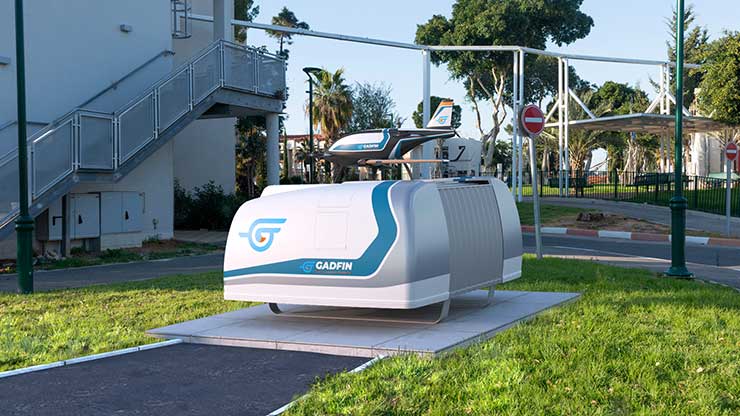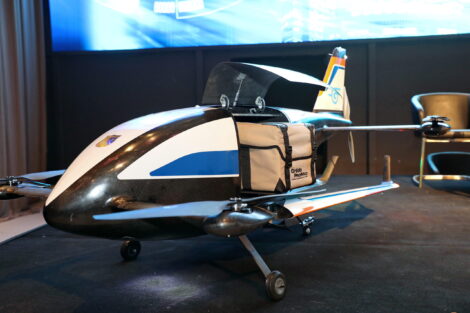
Tel Aviv: The accelerated development of drone technology makes these aerial platforms a major “player” in homeland security and disaster management systems.
Israeli company Gadfin has unveiled the next generation of drone technology, enabling for the first time, a fully autonomous drone delivery network, based on its record-breaking long range eVTOLs (one ready for market and the other under development), its fully autonomous Ground Maintenance Station (GMS-7), and enhanced flight management system.
According to the company, it is offering the world for the very first time, a 25Kg MTOW category electrical Vertical Take-Off and Landing (e-VTOL) unmanned air-vehicle with a flight range of more than 250 km (155 miles). Its flight range which is further multiplied through automated ground maintenance stations that can perform an autonomous ground cycle and relaunch the drone, makes it the optimal solution for cost-effective supply of healthcare services and devices to all corners of the globe.
Flying at 100 km/h (93 mph) based on a clean hydrogen electric energy supply, unique patents in aerodynamics, and patented folding wings, the Spirit One flies farther, faster, more quietly and more safely than any other e-VTOL in its category. Moreover, it sets a new safety standard through multiple backup and security systems .
The Gadfin autonomous long-range service – a fully autonomous B2B aerial delivery system that can create a physical internet between warehouses, hospitals and clinics around the world with a 24/7 AI managed grid, to supply on-demand delivery in a super-fast and cost-effective manner – will revolutionize the logistics supply chain and connect peripheral areas to city centres, making critical goods available everywhere. Its novel folding wings technology allows the UAV to adapt its flight mode, allowing optimal Vertical Take Off and Landing (VTOL), as well as traditional fixed wing flight, according to the most desirable mode of flight under the specific circumstances.

Eyal Regev, Gadfin’s CEO, explains: “With wings in the folded position and smaller footprint, only a small landing area is required, manoeuvrability is enhanced, and side winds are overcome. This allows the Spirit One to operate in urban settings as well as in other challenging operations, such as landing on marine vessels, ocean rigs, and buildings. When the Spirit-One reaches altitude and is ready for horizontal flight, it spreads it wings and flies long distances with great energy efficiency.”
The company is also currently developing a larger aircraft able to carry up to 100 kg (220 lbs.) for longer distances. The Gadfin Spirit-X is a ramped-up version of the Spirit One and is currently under development. Spirit-X is designed for a longer flight time – more than 500 km (310 miles), at 150 km (93 miles) an hour – and a higher maximum payload, all while maintaining e-VTOL capabilities and zero harmful emissions.
According to Gadfin, it provides unprecedented safety features: an ASTM3322-l8F compliant, independent parachute system, redundancy in all critical systems, and ADS-B + RID compliant with UTM systems standards. A multi-redundant communications system comprising an Inmarsat satellite communication system, along with a Quadra-redundant cellular communication system, and full redundancy in power system management, introduces the new benchmark for safety and airworthiness, enabling Gadfin’s drones to fly BVLOS, over populated areas, everywhere.
The company says that the fully electric platform uses both high density LiPo batteries as well as energy-rich hydrogen fuel cells. This highly efficient combination, together with Gadfin’s proprietary power-distribution module, allows drones to fly further for longer intervals. With an IP65 rating (eVTOL’s are water- and dust-resistant) and a combination of mechanical engineering and material technologies, Gadfin’s eVTOLs to operate under all normal conditions, including dust, rain, and wind.
The company says that its ground maintenance station is the first of its kind, and is fully automatic, allowing for complete unmanned operation of the Spirit One and Spirit-X long-range UAVs, including package handling and power system management.
Seven unique ground station attributes:
- Accurate take-off and landing requiring only a small footprint on the roof of any hospital, logistic facility, or on a ship’s deck out at sea.
- Monitor & control for package priorities and central command interaction via cellular communication.
- A full on-board weather station.
- No need for human intervention: A robotic system loads and unloads delivery packages on/off the aircraft, increasing safety and productivity.
- A handover window for safe interaction with the customer.
- Automatic battery replacement.
- Robotic hydrogen tank refuelling, from its independent on board, hydrogen generator.








